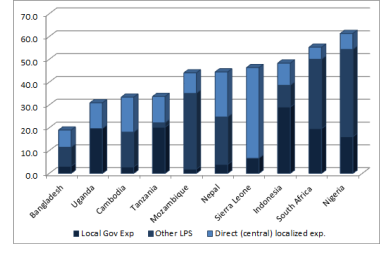
An analysis of the vertical allocation of public sector resources in ten developing countries suggests that countries with effective governments tend to spend a larger share of public resources at the local level.
Supported by a research grant from the US Agency for International Development (USAID) from January 2012 through July 2013, The Urban Institute engaged in a detailed analysis of local public sector finances in ten developing countries. In particular, the study analyzed the “vertical allocation” of resources within the public sector by considering the share of public financial resources that is spent “close to the people” within public sector at the local level.
For the purpose of this analysis, Local Public Sector Expenditure Profiles were prepared for ten countries: Bangladesh, Cambodia, Indonesia, Mozambique, Nepal, Nigeria, South Africa, Sierra Leone, Tanzania and Uganda. The analysis of these profiles uncovered that there is considerable variation in the size and composition of local public sector expenditures between countries, from less than 20% of total public sector spending in some countries to over 50% in other countries.
The analysis further suggests that in reality, countries do not rely exclusively on either devolved local governments or deconcentrated administrations to deliver public services: instead, countries typically pursue a multi-level approach to service delivery and development, by which front-line services at the local level are delivered and funded through multiple mechanisms at the same time.
Additional tentative findings from the study include:
- The organizational structure of the subnational public sector seems to have some impact on the size of the local public sector: predominantly devolved countries tend to have a somewhat larger local public sector than predominantly non-devolved countries. However, there is substantial variation in the size of the local public sector among both devolved and non-devolved countries, and a country’s organizational structure does not appear to be a dominant factor in determining the size of the local public sector.
- There is a positive correlation between the size of the local public sector and perceived government effectiveness and control of corruption. Although the direction of causality of this relationship is unclear, this study provides initial evidence that more effective public sectors spend a greater share of their resources at the local level.
- Central political contestability seems to be an important factor in determining the size of the local public sector: countries where the center has a monopoly on power tend to spend less at the local level.
- For low-income countries (below GDP of $1000 per capita), there appears to be no relationship between per capita GDP and the size of the Local Public Sector
Download and read the complete study report (PDF; 917 KB).



